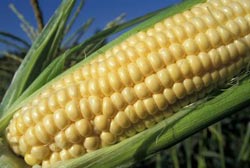Climate change may create price volatility in the corn market, say Stanford and Purdue researchers

America's No. 1 crop could see its prime growing region shift to the Canadian border or its price volatility increase sharply within 30 years. A new Stanford study points to climate change as the cause. Credit: Doug Wilson, Agricultural Research Service, USDA<br>
If farmers don't move their corn north, the more frequent heat waves could lead to bigger swings in corn prices – “price volatility” – which cause spikes in food prices, farmers' incomes and the price livestock farmers and ethanol producers pay for corn.
A study published April 22 in the journal Nature Climate Change shows for the first time climate change's outsized influence on year-to-year swings in corn prices.
Researchers from Stanford and Purdue universities found that climate change's impact on corn price volatility could far outweigh the volatility caused by changing oil prices or government energy policies mandating biofuels production from corn and other crops.
“Frankly, I was surprised that climate had the largest effect of these three influences,” said Noah Diffenbaugh, an assistant professor of environmental Earth system science at Stanford's School of Earth Sciences and a fellow at the Stanford Woods Institute for the Environment. “These are substantial changes in price volatility that come from relatively moderate global warming.”
The study, based on economic, climatic and agricultural data and computational models, finds that even if climate change stays within the internationally recognized target limit of 3.6 degrees Fahrenheit above pre-industrial levels, the temperature changes could still make damaging heat waves much more common over the U.S. corn belt.
“Severe heat is the big hammer,” Diffenbaugh said. “Even one or two degrees of global warming is likely to substantially increase heat waves that lead to low-yield years and more price volatility.”
The researchers calculate that when climate change's effects are coupled with federal mandates for biofuel production, corn price volatility could increase sharply over the period from 2020 to 2040. Increasing heat waves will lead to low-yield years, and government-mandated corn sales to ethanol producers limit the market's ability to buffer against low-yield years.
“By limiting the ability of commodity markets to adjust to yield fluctuations, biofuels mandates work in exactly the wrong direction,” said Thomas Hertel, a professor of agricultural economics at Purdue University who participated in the study.
“Our results suggest that energy policy decisions are likely to interact with climate change to affect corn price volatility, and that the market effect of a binding biofuel mandate is likely to intensify as the climate warms,” Diffenbaugh said.
Diffenbaugh and Hertel also explored the potential of farmers to adapt to the changing climate. They found that, unless corn farmers increase their crops' heat tolerance by as much as 6 degrees Fahrenheit, the areas of high corn production would have to move northward from the current U.S. corn belt to near the Canadian border in order to avoid excessive heat extremes.
“Our goal was to explore the interacting influences of climate, energy markets and energy policy,” said Diffenbaugh. “It is clear from our results that those policy decisions could strongly affect the impacts that climate change has on people. And, importantly, we also identify potential opportunities for reducing those impacts through adaptation.”
This article was written by Rob Jordan of the Stanford Woods Institute for the Environment.
Media Contact
More Information:
http://www.stanford.eduAll latest news from the category: Agricultural and Forestry Science
Newest articles

Superradiant atoms could push the boundaries of how precisely time can be measured
Superradiant atoms can help us measure time more precisely than ever. In a new study, researchers from the University of Copenhagen present a new method for measuring the time interval,…

Ion thermoelectric conversion devices for near room temperature
The electrode sheet of the thermoelectric device consists of ionic hydrogel, which is sandwiched between the electrodes to form, and the Prussian blue on the electrode undergoes a redox reaction…

Zap Energy achieves 37-million-degree temperatures in a compact device
New publication reports record electron temperatures for a small-scale, sheared-flow-stabilized Z-pinch fusion device. In the nine decades since humans first produced fusion reactions, only a few fusion technologies have demonstrated…





















